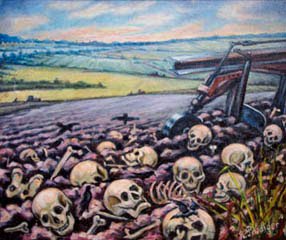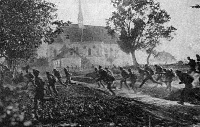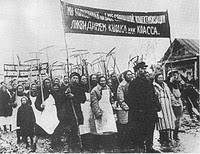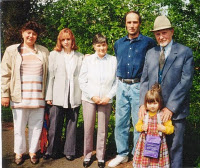
The Genocide of Russia's 'Volga Germans' - One Million Murdered, 1915-1945
(Scroll Down)*
*
*
*
*
*
*
*
*
*
*
Another 'Forgotten' Communist Genocide
"The genocide committed against the ethnic Germans of Russia comprised a series of mass murders and genocidal actions that unfolded in the 1910s, 1920s, 1930s, and 1940s. In all, from 1915 to 1945, probably over one million Russian Germans perished from unnatural causes under three successive Russian governments—those of Tsar Nicholas II, Lenin, and Stalin—chiefly by means of mass executions, forced labor, deliberate starvation, and brutal deportations." [1]
 1760s - Crown wants colonists to farm Russian land
1760s - Crown wants colonists to farm Russian land
Empress of Russia Catherine the Great, herself of German descent, published manifestos in 1762 and 1763 inviting Europeans (except Jews) to immigrate and farm Russian lands while maintaining their language and culture. [2]
 German immigrants settle along Volga River
German immigrants settle along Volga River
In the 1760s, approximately 27,000 German immigrants settled the steppes of the Russian Volga area, establishing 104 colonies on both sides of the Volga River Bank.
These German settlers came mainly from southern Germany -- including the areas of Bavaria and the Rhineland.
By 1869, the German population in the Volga region would exceed 250,000.
Prior to the onset of mass persecution, their population reaches a peak of 1,621,000 (in 1918). [3]
The war created an extreme anti-German sentiment in Russia. Approximately 190,000 to 200,000 ethnic Germans were deported from Russia from 1915-1916. The number of losses is unknown, but a mortality rate of one-third to one-half (63,000-100,000) is estimated. [4]
In 1916, an order was issued to deport around 650,000 Volga Germans to the east (Siberia) as well, but the 1917 "Russian Revolution" prevented the deportation from being carried out.
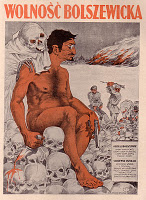 Bolshevik Red Terror, 1917-1925
Bolshevik Red Terror, 1917-1925
The jewish Bolsheviks attacked the Volga Germans with an organized campaign of terror and mass genocide following the 1917 Revolution -- including small and large scale killing operations, mass rape of women and children, torture sessions, mutilations, mass shootings of hundreds, and massacres of entire villages including the burning of all inhabitants and building structures.
On the orders of Lenin, the Bolsheviks engineered genocide by mass starvation with the requisition of grain reserves from 1920-1925.
From 1918-1925, an estimated 360,000 to 365,000 Russian Germans were exterminated through organized starvation and massacres, approximately 300,000 starvation deaths + 60,000-65,000 shootings. The number killed is approximately one-third of the entire group's 1926 population level. [5]
"Collectivization" was the Bolshevik policy of forcibly seizing private farms and handing them over to the State. Millions of farmers, including the Volga Germans, resisted. Those who did were rounded up and shot by the Cheka or deported to the gulags in Siberia. Stalin also responded by seizing food supplies, resulting in an engineered famine that resulted in the genocide of millions of people.
From 1930-1937, around 300,000 to 350,000 Russian Germans lost their lives as a result of the deliberate starvation, deportation, or massacres of resisters to "collectivization." [6] Around 7 million Ukrainians died from the same policies.
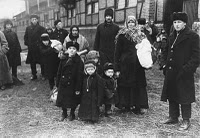 1941 - All Volga Germans Deported to Siberia
1941 - All Volga Germans Deported to Siberia
World War Two provided Stalin with the excuse to carry out the "final solution" to the "German problem" in Russia. Via formal decree on August 28, 1941, he ordered all Russian Germans deported to Siberia and other points east, citing their potential "threat" as dissidents, spies and collaborators aiding the German enemy. Approximately 440,000 Volga Germans (treated as "prisoners") were stripped of their land and houses, rounded up and transported by rail (usually in railroad freight or cattle cars) eastward to Uzbekistan, Kazakhstan, Kirgizia, Siberia, and other remote areas.
Fifty or 60 people were packed into each freight car. They were given water only when the train stopped every three or four days. The trip to Siberia could take up to 2 months. Most came unprepared for the up to -40C temps. Tens of thousands died. Some estimates indicate that close to 40 percent of the affected population perished during the journey. Corpses were left in the overcrowded cattle wagons for weeks on end, or thrown out beside the tracks.
Most of the German population that survived the journey were conscripted to the Labor Army and settled in labor camps. No one knows how many died, but scholars estimate that during the 1940s at least 300,000 Russian Germans perished, either in transport to the east or in the forests, mines and fields of Siberia. [7]
The Russian Germans have not been given back their land, nor received financial compensation for the loss of their property or for the trauma caused by the murder of their relatives.
Very few Volga Germans have returned to the Volga region. They were not allowed to settle in the area for decades. Following WW2, many remained in the Ural Mountains, Siberia, and Kazakhstan. Many others have emigrated to Germany, Canada, South America, and elsewhere.
Today, there are only approximately 600,000 ethnic Germans in Russia (2002 Russian Census), a number that increases to 1.5 million when including people of partial German ancestry. [8]
Articles/Books:
- The German-Russian Genocide: Remembrance in the 21st Century by Samuel D. Sinner
- Moscow's Final Solution: The Genocide of the German-Russian Volga Colonies by Darrel P. Kaiser
http://thy-weapon-of-war.blogspot.com/2011/10/genocide-of-russias-volga-germans-one.html

